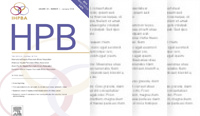International Hepato-Pancreato-Biliary Association
HPB Blog, February 2015

I often think of February as a time for reflection and to consolidate resolutions made at the New Year. This month’s edition of HPB certainly provides pause for thought with ten original articles presenting a range of problems. The journal is headed by an interesting systematic review from Henry Pleass’s group in Sydney which looks at the utility of an elevated serum lipase in diagnosing pancreatitis by looking in part at alternative causes for elevated lipase. I certainly learnt something new from this article and although we currently do not measure lipase it may have something to offer in selected patients. Next are two systematic reviews and meta-analyses which arrived from completely different parts of the world almost simultaneously. The subject in question is an important one for our readers which is comparison of outcomes from pancreaticogastrostomy and pancreaticojejunostomy in reconstruction following pancreaticoduodenectomy. One might ask why the editors have decided two almost identical studies side by side, but the methodology analysis and interpretation does differ between the studies and each provides valuable support for the other. I will leave it to the reader to explore the outcomes of these studies, which are also the subject of an editorial highlight.
The February edition of HPB also contains 3 very different articles concerning management of colorectal hepatic metastases. The first, a study from Plymouth, UK, looks at the impact of socioeconomic status on likelihood of liver resection for colorectal metastases and subsequent outcomes. This study makes slightly uncomfortable reading as financially well off patients were significantly more likely to have a liver resection than those living in deprived circumstances. The authors offer a number of explanations for this apparent inequity of healthcare access and interestingly there was no difference in outcome or survival based on socioeconomic status. The next paper on colorectal hepatic metastases, from Lille in Northern France, looks at the effect of R1 resection status on outcomes after resection in the era of chemotherapy. The authors found that the effect of R1 status was more reflective of advanced disease than prognosis or outcome per se and argue that chemotherapy has altered the way that resection margins should be viewed. This paper is discussed in the editorial highlights. The final paper on colorectal metastases is from a different group in Sydney and looks at the determinants of long term outcome in patients undergoing liver resection for colorectal hepatic metastases. They found that postoperative complications have no impact on long term outcome but that factors such as tumour size, number and resection margin had a greater impact.
The final editorial highlight focuses on an interesting paper from Cho and colleagues in South Korea which looks at the role of indocyanine green and volumetric analysis in improving safety for liver surgery in healthy and diseased background liver. This study shows that in patients with normal background liver function the conventional volumetric analysis of 25% future liver remnant volume is sufficient but in patients with cirrhosis or fibrosis the addition of indocyanine green retention at 15 minutes provides a measure of safety if the future liver remnant volume to ICG15 ratio is >1.9. This is a simple classification which may have wider applicability and it would be good to see these results replicated by another research group.
Further articles on stereotactic radiotherapy after transarterial chemoembolization for hepatocellular cancer, laparoscopy for pancreatic cancer and tumour and host biology in determining outcome after liver transplantation for hepatocellular cancer complete the February edition of HPB and will provide much opportunity for reflection, learning and discussion.
Click here for the Table of Contents
Stephen J Wigmore.
Corporate Partners
If you are interested in becoming a Corporate Partner of the IHBPA please contact industry@ihpba.org
Find out more


